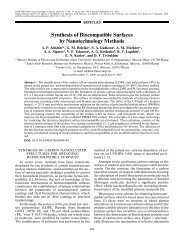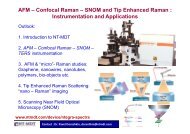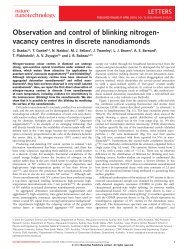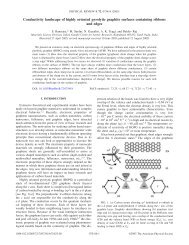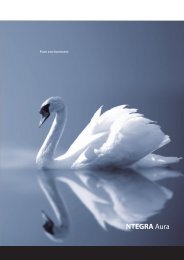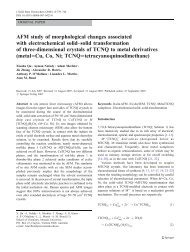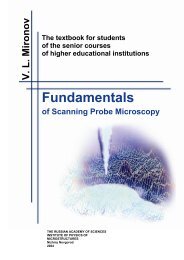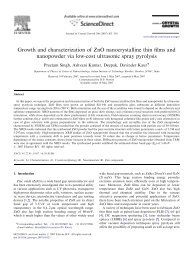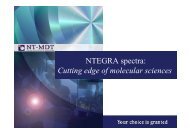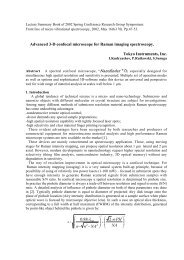A New Scanning Method for Fast Atomic Force Microscopy - NT-MDT
A New Scanning Method for Fast Atomic Force Microscopy - NT-MDT
A New Scanning Method for Fast Atomic Force Microscopy - NT-MDT
You also want an ePaper? Increase the reach of your titles
YUMPU automatically turns print PDFs into web optimized ePapers that Google loves.
This article has been accepted <strong>for</strong> publication in a future issue of this journal, but has not been fully edited. Content may change prior to final publication.10cx (µm)cy (µm)840480 0.2 0.4 0.6t (s)840480 0.2 0.4 0.6t (s)cy (µm)(a)0.40.200.20.40 0.2 0.4 0.6(b)t (s)cx (µm)0.40.200.20.40 0.2 0.4 0.6t (s)Figure 13. Closed-loop (—) and open-loop (− − −) tracking trajectory of5 Hz sinusoidal signal (left) and their corresponding cross-coupling (right).(A small phase shift was purposely added into the close-loop time responsesin order to clearly display the open- and closed-loop time responses.)the diameter of the resulting circular image consists of 512pixels. Fig. 14 (a) to (f) illustrate tracking trajectories of theCAV spirals <strong>for</strong> ω s = 31.4, 94.3, 188.5, 565.5, 754.0 and1131.0 radians/s. This corresponds to scanning frequenciesof f s = 5, 15, 30, 90, 120 and 180 Hz, respectively. Inorder to allow visual comparison of the tracking trajectories,plots in Fig. 14 (a) to (f) were made to display only thetrajectories between ±0.15 µm. It can be observed that the useof the designed feedback controllers and the shaped input haveresulted in excellent tracking per<strong>for</strong>mance of the CAV spiralsup to ω s = 1131.0 radians/s. In order to quantify the trackingper<strong>for</strong>mance, the rms tracking errors between the desired andthe achieved trajectories were calculated and are tabulated inTable I. The rms tracking error is defined as√∫1 ttotalE rms = (r(t) − r a (t)) 2 dt (46)t total 0√where r is the desired trajectory (or the radius) and r a =c 2 x + c 2 y is the achieved trajectory. Table I shows that E rmsincreases as the spiral frequency increases. This increase ismainly due to the inability of the feedback controller toaccurately track the rapid changes in the amplitude of the spiralinputs as ω s is increased. Nevertheless, at ω s = 1130.97 radians/s,E rms still remains relatively low, i.e. only 0.15 % of themaximum scanning range (spiral’s diameter).Fig. 14 (g), (h) and (i) illustrate the tracking trajectoriesbetween ±0.30 µm of the CLV spirals <strong>for</strong> v s = 0.2, 0.6 and1.1 mm/s. The values of v s were calculated using v s = ˜ω end r endwhere ˜ω end = 31.4, 94.3, 188.5 radians/s. As mentionedearlier, the CLV spiral scans were implemented in a reversedorder, that is from r end to r start . Fig. 14 (g) shows that relativelygood tracking was obtained <strong>for</strong> v s = 0.2 mm/s. However <strong>for</strong>v s = 0.6 and 1.1 mm/s, Fig. 14 (h) and (i) illustrate verylittle tracking were achieved in a small region surroundingthe center of the spirals where the frequency components ofTable IRMS VALUES OF TRACKING ERROR AND TOTAL SCANNING TIME FORCAV AND CLV SPIRAL SCANS. THE number o f curve FOR THESE SPIRALSCANS WAS SET TO 512.CAV SpiralCLV Spiralω s E rms t total v s E rms ˜t total(radians/s) (nm) (s) (mm/s) (nm) (s)31.4 2.81 51.10 0.19 3.60 25.5594.3 4.60 17.03 0.57 7.26 8.52188.5 5.19 8.52 1.13 10.67 4.26565.5 10.38 2.84 - - -754.0 11.30 2.13 - - -1131.0 18.16 1.42 - - -Table IIRMS VALUES OF SPIRAL TO RASTER POI<strong>NT</strong>S MAPPING ERROR FOR CAVAND CLV SPIRAL SCANS.CAV SpiralCLV Spiralω s f samp E mapRMS v s f samp E mapRMS(radians/s) (kHz) (nm) (mm/s) (kHz) (nm)31.4 10 2.49 0.19 10 2.6194.3 20 2.64 0.57 20 2.83188.5 20 3.12 1.13 20 3.49565.5 40 3.42 - - -754.0 60 3.51 - - -1131.0 60 3.75 - - -the input signals have increased to well beyond the bandwidthof the closed-loop system. Nonetheless, Table I shows thatthe E rms <strong>for</strong> the CLV spirals is still relatively small since mostof the tracking errors were limited only to the center of theresulting spiral scan.B. AFM ImagingHaving analyzed the per<strong>for</strong>mance of the closed-loop systemin tracking the CAV and CLV spirals, we then moved onto investigate the use of spiral scanning in generating AFMimages. The spiral scans were setup to produce images withr end = 6.5 µm and number o f curves = 512, i.e., the diameterof the resulting circular image consists of 512 pixels. Howeverbe<strong>for</strong>e per<strong>for</strong>ming the spiral scans, the RMS of mapping errorsE mapRMS <strong>for</strong> the CAV and CLV spirals scans at different angularand linear velocities are calculated and tabulated in Table II.Note that, different sampling frequencies f samp were used inorder to minimize the computing time <strong>for</strong> searching the nearestspiral point corresponding the each raster point. Additionally,the sampling frequency is also limited by computational powerof the dSPACE rapid prototyping system. Table II shows thatthe E mapRMS are very small and less then the pitch of the spiraltrajectory and the raster points, i.e., 25.44 nm. Thus, they canbe ignored.A calibration grating <strong>NT</strong>-<strong>MDT</strong> TGQ1 with a 20 nm featureheightand a 3 µm period was used as an imaging sample. TheAFM was setup to scan the sample in constant-height contactmode using a contact AFM probe with a nominal springconstant of 0.2 N/m and resonance frequency of 13 kHz. Theconstant-height contact mode was used here as the commercialAFM controller that controls the vertical positioning of thescanner is not fast enough to track the sample topography<strong>for</strong> high-speed scans. During each scan, the AFM probe isCopyright (c) 2009 IEEE. Personal use is permitted. For any other purposes, Permission must be obtained from the IEEE by emailing pubs-permissions@ieee.org.Authorized licensed use limited to: University of <strong>New</strong>castle. Downloaded on November 26, 2009 at 00:02 from IEEE Xplore. Restrictions apply.



